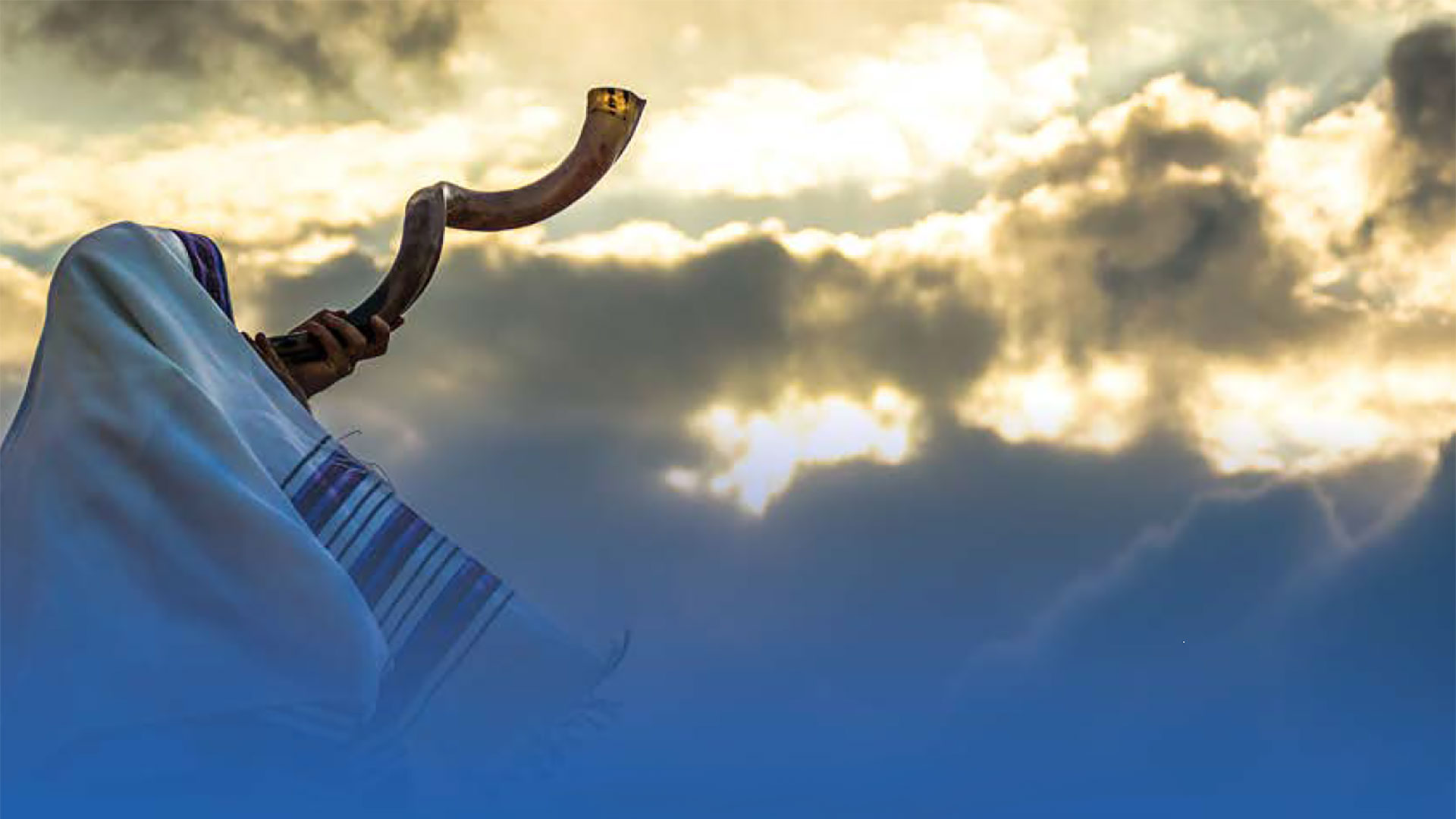The Jewish Temples
Where were they located?
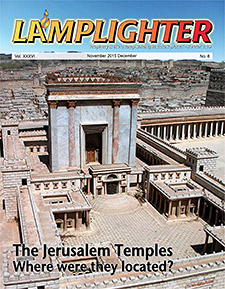
I have been receiving a lot of inquiries recently concerning a book written by Robert Cornuke that is simply titled, Temple.1 The sub-title is, “Amazing New Discoveries That Change Everything About The Location Of Solomon’s Temple,” which reads like a Madison Avenue advertising slogan.
The thesis of this book is startling. It asserts that the Jewish Temples (Solomon’s and Herod’s) were located south of the Temple Mount in the ancient City of David and that the entire Temple Mount was the Antonia Fortress where Roman troops were garrisoned.
The author, Robert Cornuke, touts himself as a “former FBI-trained police investigator.”2
Geographical Information
Before I take a look at his arguments in behalf of his radical thesis, let’s take a look at the city of Jerusalem and its historical development.
The diagram below shows what the Old City (the walled city) of Jerusalem looks like today.

The walls you see on this diagram were built by Suleiman the Magnificent between 1537 and 1541. The walls did not enclose Mount Zion which is located directly south of the Armenian Quarter, despite the fact that the Mount had always been included within the walls in previous years.
The story is the two architects of the walls cheated on the job and pocketed the money that should have been spent on the construction of the walls to encompass Mount Zion. They were executed for doing so, and their tomb can be seen today just inside the Jaffa Gate.3
What comes as a surprise to contemporary pilgrims is that none of the ancient City of David, the original Jerusalem, is enclosed within the walls as they exist today. That tiny Jebusite village that David conquered consisted of a little finger of elevated land of only 13 acres that was located directly south of the Temple Mount. Its exact location in relation to the Old City that exists today is indicated in figure 2 below.
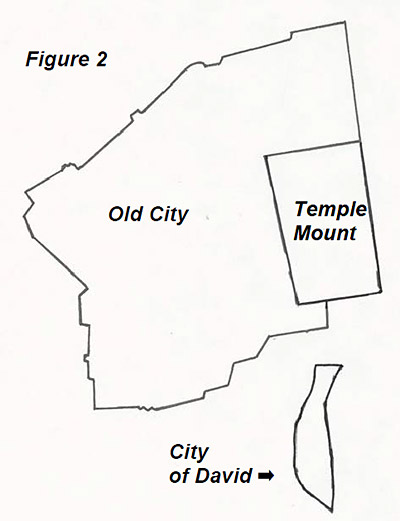
Background Information
The Bible says that in anticipation of building a temple, King David bought a threshing floor to serve as its site (2 Samuel 24:24). The traditional, historical and archaeological views have been that the threshing floor was located immediately north of the City of David on a much higher elevation called Mount Moriah. It is the opinion of most biblical scholars that this area on top of Mount Moriah, called the Temple Mount, is where Solomon’s Temple was built.
Solomon’s Temple was destroyed in 587 BC by the Babylonians who took the surviving Jews into captivity. Seventy years later, the Jews returned to Jerusalem and rebuilt what is known as The Second Temple. According to Ezra 3:10-13 this was a much less elaborate temple than the one that Solomon had built, due to the poverty of the returning refugees.
Five hundred years later in about 20 BC, King Herod the Great decided to magnify the beauty of this temple. Part of his plan was to enlarge the Temple Mount platform. To do so, he built an incredible retaining wall all around the mount and filled it with dirt to produce a very large, level platform of 36 acres. The sacrifices continued in the Temple courtyard throughout this construction process, and therefore, Herod’s Temple continued to be known as The Second Temple.
Herod’s Temple was destroyed by the Romans in 70 AD, and the Temple Mount stood vacant until the late 7th Century when a Muslim shrine, called the Dome of the Rock, was built by the Umayyad Caliph, Abd al-Malik. It was completed in 691 AD. It was supposedly built on the site of the Jewish Temple and was therefore considered to be a symbol of the triumph of Islam over Judaism. It was also considered to be a symbol of Islam’s triumph over Christianity since it stood higher than the nearby Church of the Holy Sepulcher.
In the early 8th Century an Islamic house of worship was built at the southern end of the Temple Mount, called the Al- Aqsa Mosque. Today, the Temple Mount looks like the diagram in figure 3.

In 1967, at the end of the Six Day War, the Israelis conquered the Old City and gained sovereignty over the Temple Mount for the first time in almost 1,900 years. But in order to placate the Muslim masses, Moshe Dayan, the Israeli Defense Minister, immediately announced that the Muslims would be given administrative control over the Mount.
So, today, the Muslims control the Temple Mount although Israel retains sovereignty over it. Because of the Muslim control, no archaeological research is allowed. The Israelis have dug up the area to the south of the Temple Mount and have revealed the steps leading up to the entrance gates to the Mount that were used by the general public at the time of Christ. They have also uncovered huge mikvahs (baptismal pools) that were used for ceremonial cleansing before entering the Temple complex.
Because the Temple Mount is under Muslim control, and because the Muslims are intolerant of all other religions, there are strict rules of conduct for those who are allowed on the Temple Mount. Men and women cannot hold hands. No Bible reading is allowed, and groups are not allowed to pray.
The Temple’s Location
Over the years, and continuing until today, there has been a running debate among scholars as to where the Temple was located on the Temple Mount. The majority opinion among both archaeologists and Jewish experts is that the Temple was located where the Dome of the Rock stands.4
A few have postulated that the Temple was located at the south end of the Temple Mount near where the Al- Aqsa Mosque stands today.5
The strongest alternative is the one that was proposed in 1983 by an Israeli physicist, Dr. Asher Kaufman. He believes the Temple was located about 200 feet to the north of the Dome of the Rock, and he has presented some very solid arguments for his view.6
But the bottom line is that no one knows for certain where the Temple was located on the Temple Mount, and its exact location will not be determined until archaeologists are allowed to conduct explorations on top and under the Mount.
A Revisionist Proposal
In the year 2000, a man by the name of Dr. Ernest Martin made the startling proposal that the Temple was not located on the Temple Mount at all. In his book, The Temples that Jerusalem Forgot, he presented the theory that the Temple Mount was in fact the location of the Antonia Fortress where Roman troops were garrisoned, and that the Jewish temples were located to the south of the Temple Mount in the City of David.7
Robert Cornuke has simply popularized Martin’s thesis, and he acknowledges this in the introduction of his book.8 Let’s take a look at his arguments in behalf of his thesis.
The City of David is Zion
Cornuke’s first argument, and his basic one, is that the Jewish Temples were located in Zion, and that Zion was a name for the City of David. As proof of this, he quotes 2 Samuel 5:7 which says, “…David captured the stronghold of Zion, that is the city of David.”
It is true that at the time David conquered the Jebusite city of Jebus, the Jews who subsequently occupied the city changed its name and started referring to it as The City of David or Zion, and ultimately they gave it the name of Jerusalem. But the term, Zion, is not used in the Bible to refer exclusively to the original City of David. Over a period of time, it became an alternative name for the whole city of Jerusalem as it grew north to Mount Moriah (the Temple Mount) and then started spreading west across the Tyropoean Valley.
Evidence of this can be found in Isaiah 2:3 where it says, “And many peoples will come and say, ‘Come, let us go up to the mountain of the LORD, to the house of the God of Jacob; that He may teach us concerning His ways and that we may walk in His paths.’ For the law will go forth from Zion and the word of the LORD from Jerusalem.” The last phrase of this quotation is a classic example of Hebrew parallelism whereby the second part of the phrase says the same thing as the first part, but in different words — equating Zion with Jerusalem. This sentence was written in the 8th Century BC, long after Jerusalem had grown beyond the original city of David.
Bringing the Ark Up to the Temple
Further biblical evidence that the Temple was located above the City of David on Mount Moriah can be found in 2 Chronicles 5:2 where it tells what Solomon did after he completed the building of the Temple:
“Then Solomon assembled to Jerusalem the elders of Israel and all the heads of the tribes, the leaders of the fathers’ households of the sons of Israel, to bring up the Ark of the Covenant of the LORD out of the city of David, which is Zion.”
This passage makes it clear that the Temple could not have been located in the City of David. In order for the Ark of the Covenant to be placed in the Holy of Holies, it had to be taken out of the City of David and brought up to the Temple. And what was the Ark doing in the City of David? It’s where David placed it in a tent when he brought it from Kiriath-jearim to Jerusalem (1 Chronicles 16:1).
Study the diagram on below (figure 4). The City of David is the small finger of land at the bottom, from the dotted east-west line to the south. During Solomon’s reign, the city started growing north up the Ophel (the slanted rise from the City of David to the Temple Mount). Where the Temple is located on this diagram is Mount Moriah, which today is usually referred to as the Temple Mount. And, again, notice how small the area is. The Temple Mount is 400 yards wide, but when you go south, the walls taper down to a width of less than 200 yards.
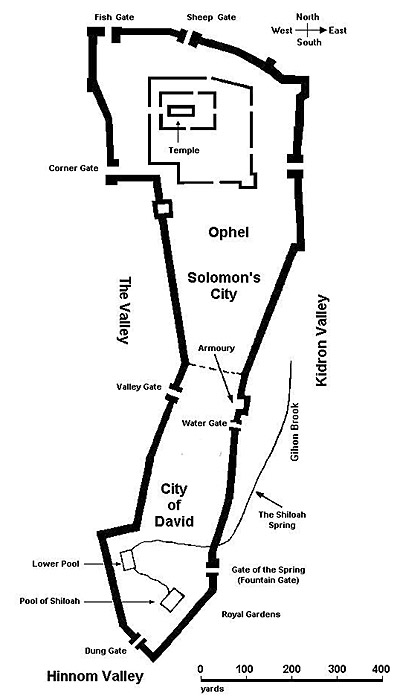
Returning to Cornuke’s basic thesis that the Temples had to be located in the City of David because it is referred to as Zion, it is a thesis that cannot be sustained.
The Threshing Floor
Cornuke’s second main argument is that the threshing floor which David purchased for the location of the Temple was situated within the City of David (2 Samuel 24:18-25). This is also a bogus argument.
Again, Cornuke’s only basis for this assertion is that since the Temple was located in Zion, the threshing floor had to be in the City of David. But the Bible says otherwise in 2 Chronicles 3:1 —
Then Solomon began to build the house of the LORD in Jerusalem on Mount Moriah, where the LORD had appeared to his father David, at the place that David had prepared on the threshing floor of Ornan the Jebusite.</span
This verse makes it very clear that the threshing floor on which the Temple was built was located on Mount Moriah, and not in the City of David. Furthermore, threshing floors in biblical times were never located inside cities. Instead, they were located on high places in agricultural areas where the wind could catch the chaff.9
Cornuke makes the bizarre claim that the threshing floor that David purchased was actually located over the Gihon Spring in the City of David. But as one of his critics has put it:10
The reason the Temple was not built on top of the Gihon Spring is the same reason people do not put a toilet in the middle of the kitchen table where food is eaten. The temple was built on a threshing floor. Threshing floors are dirty and were never built near springs. The particles would contaminate the water as the chaff from the wheat was blown away from the husk.
All these factors make it clear that a threshing floor inside the tiny City of David is just not a possibility.
The Water
Cornuke’s third major argument relates to the Jewish Temple’s need for abundant water in order to wash away the blood of animal sacrifices. He asserts that because of this need, the Temple had to be situated in the City of David over the Gihon Spring. He cites two biblical passages — Joel 3:18 and Ezekiel 47:1-7 — to prove that the Gihon Spring was under the Temple.
The passage in Joel says, “…and in that day the mountains will drip with sweet wine, and the hills will flow with milk, and all the brooks of Judah will flow with water; and a spring will go out from the house of the LORD to water the valley of Shittim.” Similarly, the passage in Ezekiel says that water will flow from under the threshold of the Temple. The water will form a river that will flow to the Dead Sea, and when it reaches that point, it will refresh the sea and bring it alive with “living creatures.”
The problem with these passages is that they are both presented in a Millennial context, and therefore they have nothing to do with the biblical temples. The verses are talking about the Millennial Temple which will be built after Jesus returns. And keep in mind that the Bible says that when the Second Coming occurs, there will be the greatest earthquake in history — one that will impact the entire world (Revelation 6:12-17 and Revelation 16:18-20). Every island will be moved. Mountains will be lowered, plains will be lifted, and the topography of Jerusalem will be drastically changed (Zechariah 14:10). So, there is no way that Cornuke can prove that these verses are talking about the Gihon Spring.
The fact that the topography of Jerusalem is going to be radically revised is attested to by the size of the Millennial Temple that is described in Ezekiel 40-48. Bible prophecy expert Dr. John C. Whitcomb describes it this way:11
The area of the Temple courts (500 x 500 “reeds,” or about one square mile) would be larger than the entire ancient walled city of Jerusalem, and the holy portion for priests and Levites (20,000 x 25,000 reeds, or about 40 x 50 miles) would cover an area six times the size of greater London today and could not possibly be placed within present-day Palestine, that is between the Jordan River and the Mediterranean Sea (Ezekiel 47:18), to say nothing of the “portion of the prince” on either side of this area (Ezekiel 45:7, 47:21). The Millennial Jerusalem would be about 40 miles in circumference and thus ten times the circumference of the ancient city. Furthermore, it would be somewhat north of the present site of the city, and the Temple area would be about ten miles north of that, on the way to Samaria!
The map below (figuire 5) shows the size of Millennial Israel and the gigantic size of the Temple area. As you can see, the Temple area will be so big that it will extend over the Jordan River as it exists today.12
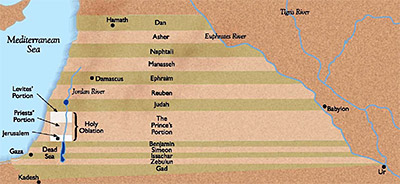
It is true that the Temples required a lot of water for the cleansing of the sacrificial altars. But that water was supplied by an aqueduct that Solomon built about 950 BC. It transported water to the Temple Mount from the Spring of Atan which was located near Bethlehem.13
The Stones
One of Cornuke’s cornerstone arguments that he emphasizes repeatedly is that Jesus prophesied that the entire Temple complex would be destroyed to the point that “not one stone will be left upon another” (Matthew 24:2). He then points out that the retaining walls of the Temple Mount remain standing to this day. Therefore, he concludes that the Temple could not have been located on the Temple Mount. In contrast, he points out that nothing is left of the Temple in the City of David.
This argument is nothing but hot air. Jesus did not prophesy the destruction of the Temple complex, and the reason there is nothing left of the Temple in the City of David is because it was never there.
You can find Jesus’ prophecy in three places: Matthew 24:1-2, Mark 13:1-2 and Luke 21:5-6. In all three places it is very clear that His prophecy relates only to the buildings on the Temple Mount and not to the retaining walls around the Mount. Consider Matthew 24:1-2 —
1) Jesus came out from the temple and was going away when His disciples came up to point out the temple buildings to Him.
2) And He said to them, “Do you not see all these things? Truly I say to you, not one stone here will be left upon another, which will not be torn down.”
As you can clearly see in this passage, the prophecy relates to the Temple buildings, and not the retaining walls.
The Coin
Cornuke makes a big deal out of a coin that archaeologists found at the base of the southwest corner of the Temple Mount retaining wall. He says the coin was dated 20 AD and it proves that the walls were not completed by that date. He concludes that the western wall was not built by Herod, and therefore Herod’s Temple could not have been located on the Temple Mount.
The fact of the matter is that the construction of the Temple complex continued long after King Herod’s death. John 2:20 says that the building of the Temple complex took 46 years — until about 27 or 28 AD. And recent archaeological excavations have revealed that although the Western Wall, where Jews pray today, was built in Herod’s lifetime, the southwest corner of the Temple Mount where the coin was found, was not completed until around 30 AD.14 In fact, Josephus reports that the Temple complex was still receiving further embellishments and repairs right up to the time that the First Jewish Revolt broke out in 66 AD.15
The Debris
One important point that Cornuke overlooks is that there is tons of debris on the east and west sides of the Temple Mount. This rubble was piled up when the Roman soldiers pushed the stones of the Temple buildings off the top of the Temple Mount.
This debris is so deep that when people stand at the Western Wall (or “Wailing Wall”) today, they are actually standing 50 feet above the base of the wall where a street was located in the time of Jesus. On the eastern side of the Temple Mount, the debris is so deep that it covers the top of the ancient Eastern Gate which exists directly below the present gate.
This leads to a crucial question: If the Temple Mount was the location of the Roman fortress, why did the Roman soldiers tear down their own fortress and then go to the enormous trouble of pushing the remains over the top of the Temple Mount? It just makes no sense.

Excavations
Since 1967, when the Israelis reconquered the Old City in the Six Day War, they have excavated the southern end of the Temple Mount. They found the steps leading up to the entrance to the Temple complex. And they uncovered huge ceremonial baths (mikvahs) which were used for spiritual cleansing before entering the Temple.
The discovery of these baths solved a mystery that appears in Acts chapter 2. That chapter records the first Gospel sermon that the Apostle Peter preached on the Day of Pentecost — a sermon he presented on the Temple grounds. We are told that 3,000 responded to the sermon and were baptized. Scholars have always wondered where that many people could have been baptized in Jerusalem. Now we know.
The Israelis have not carried out excavations on the east side of the Temple Mount because a Muslim cemetery is located there. The graves are located on top of the tons of debris that is piled up against that wall.
On the west side, they are unable to conduct excavations because buildings have been built over the debris right up to the wall. The only open space is the Western Wall where Jews go to pray, and it is considered to be a sacred and untouchable area. But excavations have been conducted at the southwest corner of the Western Wall. The photo below shows that corner and some of the huge stones that were pushed off the top of the Temple Mount.
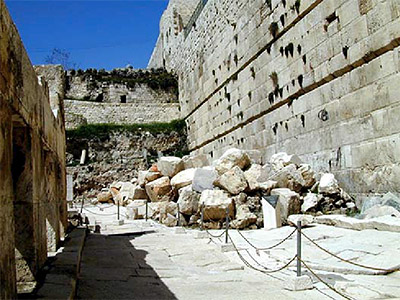
In the midst of the rubble that has been left at the southwest corner of the Temple Mount is a stone that is inscribed with the words, “To the place of trumpeting.” It marks the spot at the top of the Temple Mount where the priestly trumpeter would have stood to sound the trumpet signaling the beginning and end of Sabbath days and festivals. This stone clearly indicates that the Temple Mount was a Jewish sacred place, and not the site of a Roman fortress.
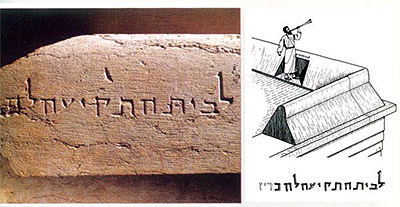

Warning Signs
Something Cornuke did not mention in his book is that two warning signs have been discovered that clearly indicate the Temple was located on the Temple Mount. These are signs that warned that non-Jews could not cross the stone balustrade that separated the sacred Temple area from the Court of the Gentiles. These signs are mentioned in the writings of Josephus.16
The first of these signs carved in stone was found in 1871 near the Lion’s Gate located at the northeastern corner of the Temple Mount, nowhere near the City of David. A second one was discovered in the 1930’s near the same location.17

The Size
One of the most devastating arguments against Cornuke’s theory relates to the size of the Temple platform on which the Temple sat. According to both Josephus and the Mishnah (a collection of rabbinical oral traditions), the Temple platform was 500 by 500 cubits in size. The cubit used by Solomon was the long royal Egyptian cubit which was 20.67 inches long.18 That would make the Temple platform 861 feet square.
There is simply no way that this platform could have fit in the City of David. Again, the City of David was a tiny village when David conquered it. It consisted of only 13 acres and was 400 feet wide by 1,800 feet long. The placement of a temple platform 861 feet square in the village would look like the diagram below.
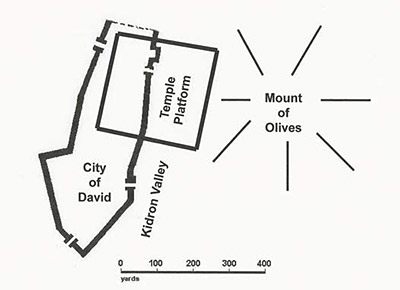
As you can see, the Temple platform would have stuck out over the deep Kidron ravine, hanging in the sky! In Cornuke’s book, he has some drawings he commissioned showing the Temple sitting in the City of David, but they are very misleading because they are not drawn to scale.
Concluding Thoughts
Cornuke offers some other arguments in behalf of his theory, but I have covered all the main ones.
I think it is important to note that the leaders of the Temple Mount Institute in Jerusalem are the world’s leading experts on the Jewish Temples. They have spent their lives studying the ancient manuscripts related to the Temple, and their conclusion is that “…there is no doubt that the Dome of the Rock is the location of the First and Second Temples…”19
One of Christendom’s foremost experts on the Temples, Randall Price, agrees with this conclusion. He further observes, “…while evidence of the First Temple’s construction is scarce… evidence for the Herodian Second Temple is replete, both in the original documentary sources and the archeological remains.”20 And he then points out that the Bible explicitly states that the Second Temple was built on the foundation of the First (Ezra 2:68 and 9:9).
The cover of Cornuke’s book has a superscription above the title which reads: “Could History Be So Stunningly Wrong?” The answer is a resounding “No!”
References
1) Robert Cornuke, Temple: Amazing New Discoveries That Change Everything About The Location of Solomon’s Temple (Charlotte, NC: LifeBridge Books, 2014).
2) Ibid., back cover.
3) Galyn Wiemers, “Temple Mount of Solomon,” www.generationword.com/jerusalem101/21-temple-mount-of-solomon.html.
4) The Temple Mount Faithful, “The Location of the Temple and the Holy of Holies on the Temple Mount: The Present Dome of the Rock is the Location of the Temple and the Rock Which is Under the Dome of the Rock is the Location of the Holy of Holies,” http://templemountfaithful.org/articles/temple-location.php.
5) Lambert Dolphin and Michael Kollen, “On The Location of the First and Second Temples in Jerusalem,” www.temple mount.org/theories.html.
6) Joshua Schwartz, “The Temple Mount: Where is the Holy of Holies?” (A review of Asher Kaufman’s book by the same name), www.biblical archaeology.org/reviews/the-temple-mount.
7) Ernest Martin, The Temples that Jerusalem Forgot (Portland, OR: Associates for Scriptural, Knowledge, 1994).
8) Cornuke, page 14.
9) Leen Ritmeyer, “Where the Temple Didn’t Stand,” World of the Bible News, Summer 2001, volume 3, number 4, page 2.
10) Steve Rudd, “Temple is not located on top of the Gihon Spring,” www.bible.ca/archaeology/bible-archaeology-jerusalem-templemount-ophel-gihon-spring.htm, page 1.
11) John C. Whitcomb, “The Millennial Temple of Ezekiel 40-48,” www.middletownbiblechurch.org/proph/templemi.htm, page 4.
12) Tim LaHaye and Thomas Ice, Charting the End Times (Eugene, OR: Harvest House, 2001).
13) The Interactive Bible, “The Jerusalem Water Aqueduct 12km from the Solomon’s Pools,” www. bible.ca/archeology/Biblearcheology-jerusalem-temple-mount-threshing-floor-aqueduct.htm.
14) Gordon Franz, “Was King Solomon’s and Herod the Great’s Temples Built Over the Gihon Springs in the City of David?: A Factual Review of Robert Cornuke’s Temple,” draft article shared with the author by Randall Price, page 19.
15) Flavius Josephus, Antiquities, 20.219.
16) Josephus, Wars 5.193-194 and Antiquities, 15. 417.
17) Franz, page 23. Also, Randall Price, “Where Was the Temple Located?” http://www.worldofthebible.com/Documents/Where%20was% 20the%20Temple%20Located2.pdf, pages 8-9.
18) Wikipedia, “Cubit,” https://en.wikipedia.org/wiki/Cubit#Ancient_Egyptian_royal_cubit, page 1.
19) The Temple Institute, “The Location of the Temple and the Holy of Holies on the Temple Mount: The Present Dome of the Rock is the Location of the Temple and the Rock Which is Under the Dome of the Rock is the Location of the Holy of Holies,” http://templemountfaithful.org/articles/temple-location.php, page 12.
20) Randall Price, “Where Was The Temple Located?” www.worldofthebible.com/Documents/Where%20was%20the%20Temple%20 Located2.pdf, page 2.


